Filter by topic
-
Order a translation
Advantages over working with a translation agency
- You can pay in installments, which reduces your financial risk
- You can follow the translation live, so you can have adjustments made by contacting the translator
- The translator receives a larger share of the word rate, which benefits the overall quality of the translation (the best translators work with us)
- Inexpensive compared to traditional translation agencies
- The possibility to connect the Fairlingo translation API to your CMS, online store, website or ERP system
Advantages over working with a freelancer
- You can pay in installments, which reduces your financial risk
- Better availability and more areas of expertise covered
- Higher quality, because the translations are checked by other translators
- You can follow the translation live, and have adjustments made if necessary
As a client, you can choose among three difficulty levels: basic, regular and specialist. Every text will be given a high-quality translation. The difficulty level of the text is used to select the right translators for the job.
When to choose which level:
Basic
For general texts that contain few to no specific terms, but do require a proper translation. Examples include product descriptions, FAQ's, and manuals. The text is pre-translated by sophisticated translation software. Then, the text is thoroughly revised by a native speaking translator.Regular
The text contains some specific terminology, but an experienced translator with a good dictionary will be able to do a stellar job. Examples include website content, brochures and newsletters.Specialist
These are highly specialist texts that can only be translated by people with a technical, legal or medical background. Contracts, specialized reports and complex manuals, for instance.What if I select a level that’s too low for the text?
It might be tempting to go for a lower rate. However, translators might not accept the assignment, they might take longer, or the quality simply won’t be up to your standards. We strongly recommend that you assess the difficulty of your text so our translators can deliver the best possible translation.
An account is created automatically when you request a quote, or you can click here to create a Fairlingo account.
You can easily request and accept a quote through our website:
- Go to our website and click here to get a quote within 30 seconds.
- Confirm if you want to accept the quote.
- The translation process will start as soon as we have received payment (post-payment is possible in consultation).
- Log in to your Fairlingo account and click on 'Create new translation order'
- Fill in the required information and click on 'Calculate costs within 30 seconds'
- The quote will be displayed
- The quote can be confirmed by clicking on 'Confirm this quote'
If you create an assignment as a client, Fairlingo will automatically draft a free quote. It will display the word count, the deadline, the difficulty of the text, and the costs of the translation. You can accept the quote immediately if you so choose. The assignment will only be started after it has been accepted.
- Click here to request a quote for a website translation.
- Fill in the domain name or upload a .xlsx file with URLs.
- Fairlingo automatically counts the amount of words and creates a quote. You can download a file with the texts that have been processed.
Website files
You can download the translation in these file formats:- .docx
- .txt
- .xlsx
- .csv
- .po
- .xliff
- .rtf
We can translate the following file types
- .docx
- .txt
- .xlsx
- .csv
- .po
- .xliff
- Wordpress .xml
There is a lot of information available on the internet about how to convert various file types into these formats. Please contact us at info@fairlingo.com if you need help.
Fairlingo translation API
We provide high-quality human translations using an easy-to-implement API. You can directly connect the API to your online store, website, CMS and ERP system.
-
Translation quality
The quality of translations at Fairlingo is similar to that of reputable translation agencies, or a strong collaboration between skilled freelancers, but the rates are far more competitive.
We accomplish this by:
- Having translators check each other’s translations
- Working with various difficulty levels for the translators
- Implementing motivating gamification elements
- Using a unique algorithm that safeguards quality
- Lower overhead costs through clever automation
Fairlingo maintains the layout of the source file. This means:
- Maintaining font type, font size and images
- Maintaining the spaces between sentences and paragraphs
Because the text is translated into another language, the word count may differ from the source text. This varies depending on the language, as languages express ideas in different ways.
Our philosophy is to offer high-quality translations. We developed a special algorithm for that purpose. However, should you be unhappy with your translation, we will adjust the text for you free of charge within 30 days. In this case, we kindly ask you to send your request to info@fairlingo.com.
-
About the deadline
Chances of a deadline not being met are slim (comparable to a traditional translation agency). This is because our algorithm keeps track of the translation and takes action in case the translator misses the deadline.
The deadline for a translation is based on the amount of text. If you need the translation sooner, you can split the translation into multiple orders. These assignments can be performed simultaneously (by several translators), which means that the entire text can be translated faster.
-
Communication with Fairlingo
Fairlingo is a digital translation agency. Our software automatically assigns the most suitable translator to your order. Therefore, you do not have to contact one of our project managers to start a translation. However, if you have any questions our project managers are happy to help.
You can send any translation related questions, ideas and comments to info@fairlingo.com.
-
Payments and invoices
You will receive your invoice as a .pdf document by email within 24 hours after payment. This email also contains a direct link to the invoice.
You can also download the invoice if you are logged into your account. You can find the instructions here.
- Log in and go to your dashboard (figure 1)
- Click on 'Buy credit' (figure 2)
- Choose a custom amount or select a fixed amount and click on 'Buy translation credit' (figure 3)
- Select a payment method and confirm (figure 4)

Figure 1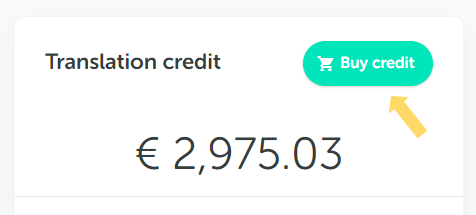
Figure 2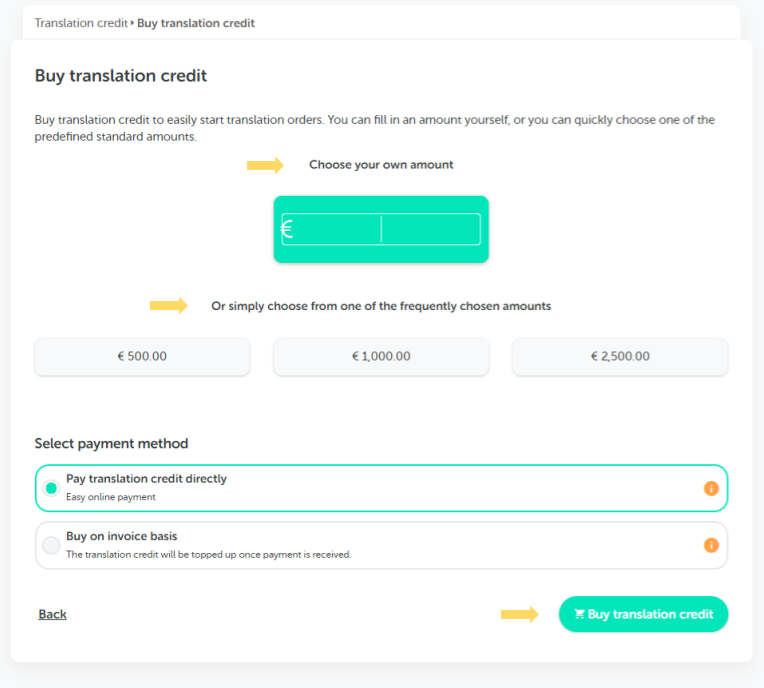
Figure 3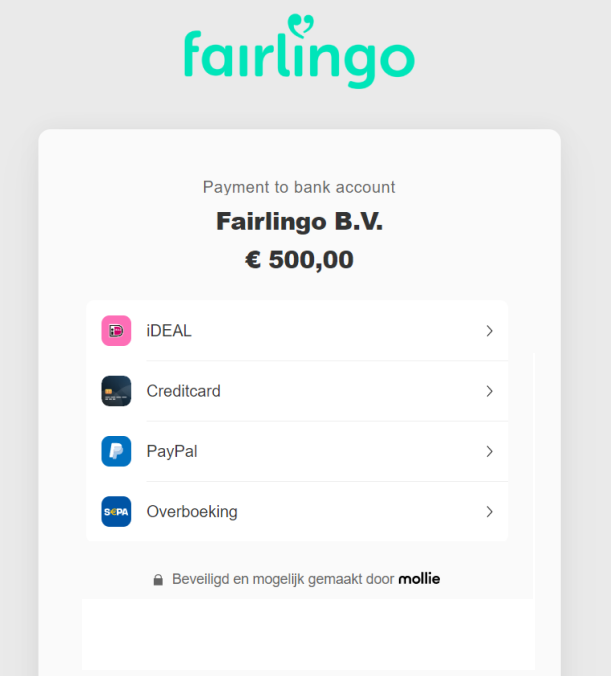
- Login to your Fairlingo account and go to 'Settings' (figure 1)
- Go to 'Invoices' (figure 2)
- If necessary, update your invoice details at 'Account details' (figure 3)
- You can download the invoice at 'Invoices' (figure 2). Please read the note below.
Note
Fairlingo is updating the invoices every 24 hours. So after filling in your payment details it can take up to 24 hours until the first or a new invoice is created.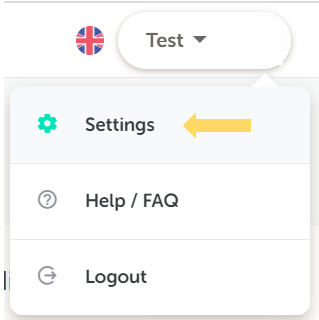
Figure 1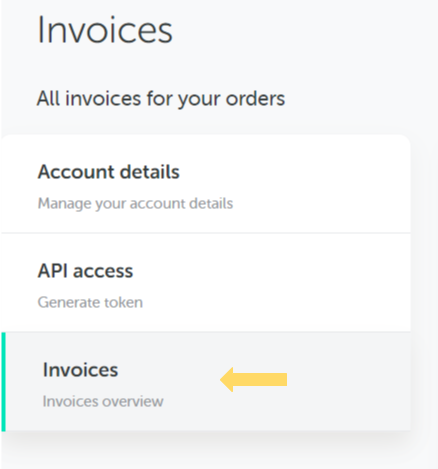
Figure 2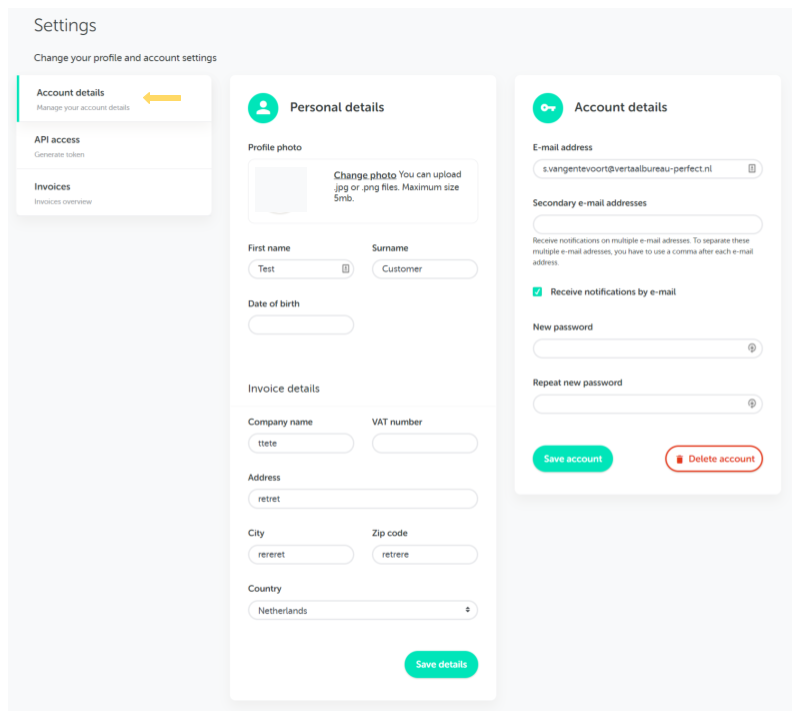
Figure 3
- Login at Fairlingo and go to 'Settings' (figure 1)
- Go to 'Account details' (figure 2)
- Update your payment details at 'Invoice details'
Note
Fairlingo is updating the invoices every 24 hours. So after changing your payment details it can take up to 24 hours until the first or a new invoice is created.
Figure 1
Figure 2
Unfortunately, it is not possible to transfer the money in your account back to your bank account. We therefore recommend to make absolutely sure that you intend to use the money in your account for translations.
-
After the translation is complete
If you are logged into your account, go to 'My translation orders'. Here you will find an overview of your completed translations and your unconfirmed translation orders.
Above the orders you see the filter (Figure 1). You have three options to filter your orders:
- Enter a term or order number in de "Search" section
- Select the source language and/or target language
- Select a date to search orders created on or after that date
You can use one or more of these options. Once you are finished, click on the magnifying glass icon and the corresponding orders will appear on your screen.

Figure 1
If you have any questions with regard to the completed translation, you can contact one of our project managers at info@fairlingo.com.
-
Translation memory & termbase
What is a translation memory?
In order to improve both the speed and consistency of our translations, we use translation memories. A translation memory is a database that stores "segments", which can be sentences, or sentence-like units (headings, titles or elements in a list) that have previously been translated, in order to aid human translators.
Text analysis
Every text is automatically analysed for repeat segments. You can find this analysis in the quotation.You get a discount for segments that are repeated in the document and for segments that are already present in your translation memory.
How does the translation memory work?
Based on prior translations, the translator gets suggestions for the translations of segments that in your current assignment. This way, the consistency level and completion speed of your translations can increase with every assignment. Of course, the translator and the revisor will check whether the translation memory suggestion is the best translation in the current context, and they will correct this if necassary.
Upload your own translation memory
If you want to add words or segments that need to be translated in a specific way, you can add your own translation memory. To do this, you need to create a .tmx document. You can easily find free CAT-tools on the internet to create a .tmx file.
Some important instructions for the .tmx document:
1. Create a translation memory for every language combination you need. You can't combine multiple language combinations in one document.
2. Create 2 columns, insert the source language in the first column and the target language in the second column.
To upload a translation memory, follow these steps:
- When you are logged in at Fairlingo, go to Settings (Figure 1)
- Click on Translation Memories (Figure 2)
- Click on Create New (Figure 3)
- Select the Source language, the Target language and upload the .tmx file (Figure 4)

Figure 1

Figure 2

Figure 3
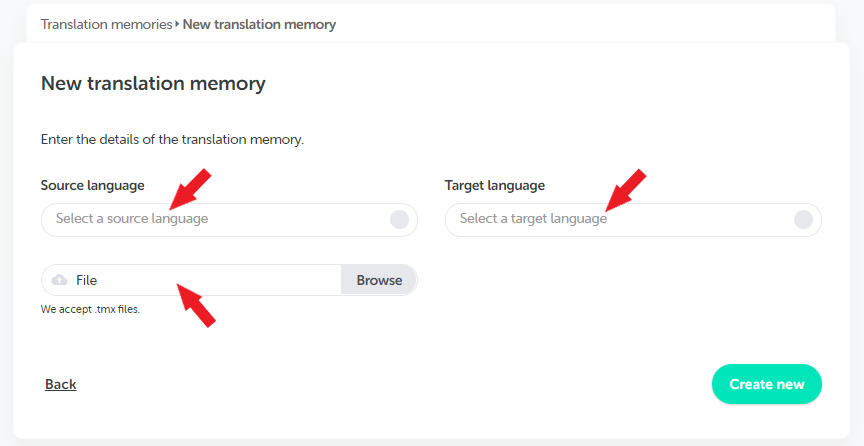
Figure 4
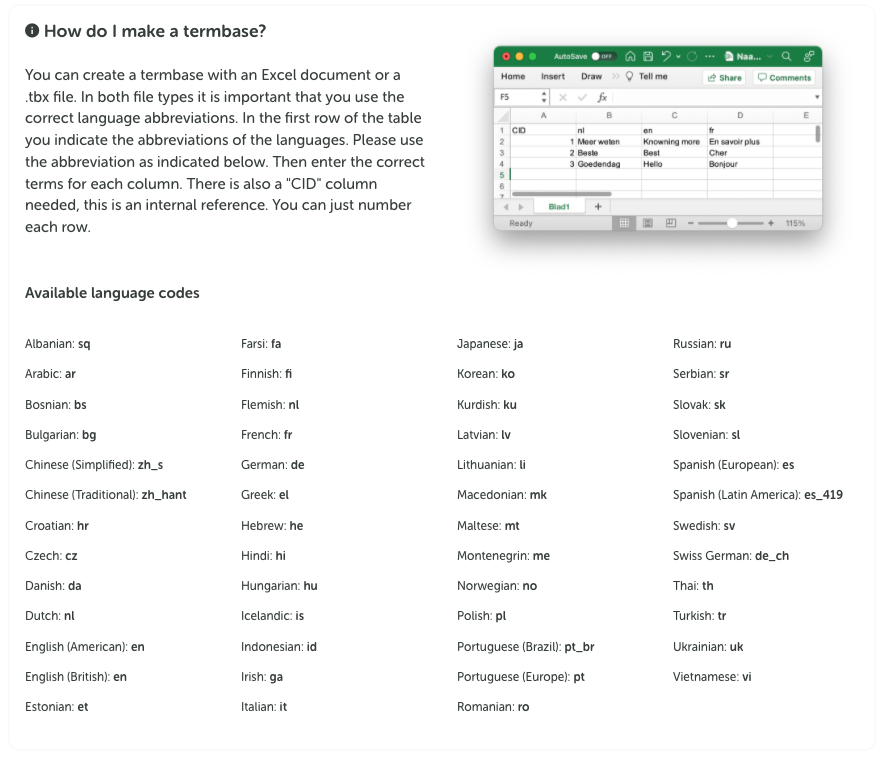
You can upload a termbase and indicate the source language and target language. The termbase is then applied to all assignments for this language combination.
An existing termbase can be modified/adjusted. The modified termbase is then applied to all commands for this language combination.
If a word from the termbase appears in the source text, it is suggested to the translator during translation. The termbase takes precedence over the translation memory.
Uploading a termbase
1. Go to your Fairlingo profile and choose 'Settings' (figure 1)
2. At left, you see a menu. Choose 'Translation memories' (figure 2)
3. Press te green button 'Create new' at the section 'Termbase' (figure 3)
4. Enter the details of the termbase (figure 4)
5. Submit termbase by pressing the green button 'Create new' at the bottom of the page (figure 5)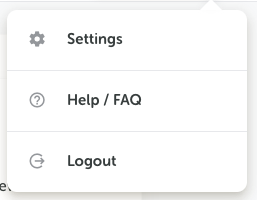
Figure 1

Figure 2

Figure 3

Figure 4

Figure 5
-
Other Questions
Can't find the answer to your question on this page? Contact us at info@fairlingo.com or tel: +31 (0)53-2030 046 and we will be happy to help you.